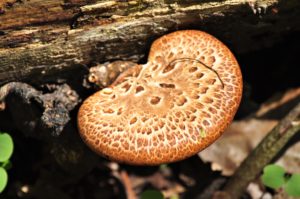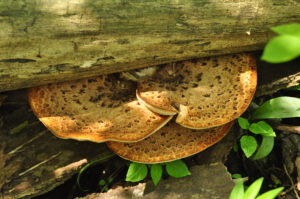Photography courtesy of Lowell Washburn, all rights reserved.
The morel mushroom reigns as undisputed King of the Wild Edibles. In Iowa, as elsewhere, Morel Mania is rampant. The elusive fungus is in so craved, in fact, that people who can’t find them buy them. But store bought morels aren’t cheap. At roadside stands and Mississippi River fish markets, these woodland taste treats are currently fetching $34 per pound – saw it for myself. As always, demand is high. In spite of the price, vendors are selling all they can get their hands on. I’m told that morels are bringing even more in the city; but I wouldn’t know. Whenever possible, I try to avoid being around that much concrete.
Although I’m dining on some big yellows, 2017 is not going to be remembered as one of my best years. But I’m far from feeling down and out over the matter. There are plenty of other wild edibles standing in our local woodlands. One of the most common is a familiar mushroom frequently referred to as the Pheasant Back. Known to science as Polyporus squamosus, the Pheasant Back is a shelf or bracket mushroom that grows [more or less] horizontally from trunks, stumps, or fallen logs. When young and still growing, the mushroom’s top side is a rich tan in color and is sporadically accented by darker scales that have a feathery appearance – something like a pheasant’s back; or at least that’s the conclusion some folks draw.
Pheasant Backs – more properly known as Dryad’s Saddle – can be one of the best, or one of the worst, of Iowa’s wild edibles. Age is the key. If captured while still young, they are simply out of this world. They are so delicious, in fact, that I prefer them – hands down – to the best and freshest morels. The very best specimens will be no larger than your hand. They should feel ‘plump to the touch’ and be full of moisture. The larger they get, the tougher and more tasteless they become. Mature mushrooms are virtually inedible. Those in between can still be utilized by cutting away the harder core and salvaging the softer [outer] portions. But when it’s all said and done, nothing beats the small ones for flavor.
Pheasant Backs go best with white meat like pheasant breast [go figure], wild turkey, or if you have to – chicken. They can be grilled, baked, or used to make an incredible broth. Some cooks scrape away the pores from the mushroom’s soft underside. Don’t know why they do that; I never have. My favorite cooking method is to simply chunk them up into one-inch cubes and sauté in butter or olive oil until well browned. Sometimes, I’ll cook them longer until the edges start to crisp which gives them an entirely different flavor. Whether lightly sautéed or fried crispy, fresh Pheasant Backs never disappoint. Although all mushrooms are poisonous at some level [including the tame ones you buy at the local grocery], I’ve never heard of anyone getting sick from eating too many Pheasant Backs. Safe and delicious, they are one of Iowa’s Four Star taste treats!



 Tom Cope
Tom Cope Sue Wilkinson
Sue Wilkinson Susan Judkins Josten
Susan Judkins Josten Rudi Roeslein
Rudi Roeslein Elyssa McFarland
Elyssa McFarland Mark Langgin
Mark Langgin Adam Janke
Adam Janke Joe Henry
Joe Henry Kristin Ashenbrenner
Kristin Ashenbrenner Joe Wilkinson
Joe Wilkinson Dr. Tammy Mildenstein
Dr. Tammy Mildenstein Sean McMahon
Sean McMahon